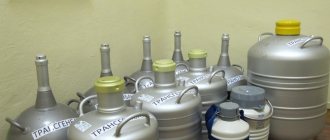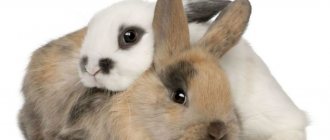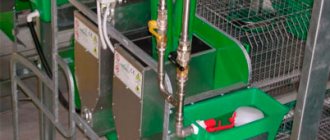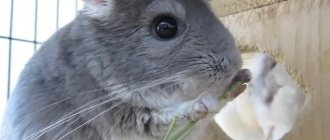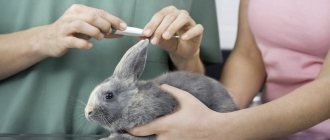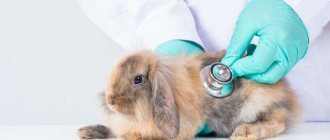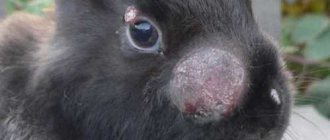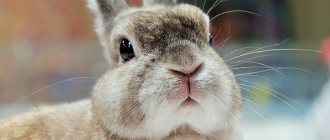The method of artificial insemination of farm animals in Russia, unfortunately, is not particularly popular. However, the experience of European and American farms has shown the high efficiency and profitability of this technology. Artificial insemination of rabbits, for example, makes it possible to obtain purebred and absolutely healthy offspring in large quantities. The only thing is that it is believed that this method of restocking is best suited for large farms specializing in breeding such animals.
Features of natural reproduction of rabbits
As you know, these animals are highly fertile. Even for beginners, raising rabbits at home is usually not a particularly difficult procedure.
On Russian farms, reproduction of these animals usually occurs naturally. On farms of this specialization, 10 queens most often contain 1-2 males, and, for example, 200 - 40. Females of these animals can give birth to cubs once every two months. However, rabbits are usually not brought together with males so often on farms. Childbirth every two months leads to rapid wear and tear on the animal’s body. Females are usually seen with rabbits on farms once every four months. That is, such animals are capable of producing 3 litters per year. In this case, one female gives birth to 6 to 12 cubs.
Recommendations for artificial insemination of rabbits at home
The process of artificial insemination of rabbits at home is in most details similar to that which occurs on an industrial scale. But when preparing and actually mating rabbits, there is always room for unexpected surprises and even troubles. These are the ones you should prepare for in advance.
First of all, this concerns the behavior of the animals themselves and their well-being. In practice, there are cases when partners proposed to each other cannot get along, begin to jump on each other and are even ready to tear apart the unsuitable partner. No less rare are cases of turning over all the food and drinking bowls during “games”. If existing utensils break, their sharp edges may injure animals. If a female is extremely obese, she is likely not suitable for the desired mating.
Read also: How to treat endometritis in cows
When planning artificial insemination, it is ideal to choose females in heat that carry hay in their teeth and pluck their fluff. Such rabbits, as a rule, have large and healthy offspring as a result of one litter. You can check whether insemination was successful by placing the male rabbit again. Pregnant females do not react to their partner in any way and refuse his attention or show aggression towards him, but not favor.
Difficulties of natural reproduction
Producers in such farms are selected mainly based on breed characteristics and the degree of sexual activity. Of course, before allowing a rabbit to meet females, among other things, its health is checked. Producers that have not proven themselves well in terms of producing a large number of strong rabbits are subsequently discarded. The method of selecting males to replenish the herd on farms is therefore quite complex.
But despite this, unfortunately, not all rabbits have excellent characteristics as producers on farms. It is often expensive for a large farm to purchase a large number of good males. The answer to the question of how much a purebred rabbit costs can be, for example, an amount of 2-4 thousand rubles. In this case, it is advisable to introduce artificial insemination techniques on the farm.
How cost-effective is artificial insemination?
In most farms, fertilization of females occurs naturally. Not every breeder is willing to pay his own money for the purchase of seed material and its research (especially if the rabbit population is not so large).
Artificial insemination can be justified (as well as the costs for it, if you plan to simultaneously cover several dozen females, whose total number gives a number of more than 1000 animals per month). Only with this approach will this technique pay off; in all other cases it is unprofitable.
Technology in brief
When using this technique on farms, sperm is first collected from the best purebred males. To stimulate sexual activity, a female is first placed with such a breeder. After the rabbit is aroused, its sperm is collected in an artificial vagina.
The material obtained in this way is usually frozen. Store high-quality rabbit sperm in special containers in liquid nitrogen. If necessary, the material is subsequently thawed and injected into the rabbit’s uterus.
Features of artificial insemination
Ovulation in rabbits, unlike other farm animals, occurs directly during sexual intercourse due to strong arousal. Therefore, before artificial insemination, female rabbits on farms are first mated with some infertile male. Also, special drugs can be used to stimulate ovulation in rabbits.
Thawed sperm is injected into females directly into the uterus. In this case, a specially designed syringe is used to perform the procedure.
Artificial insemination of rabbits, taking into account physiology
To understand the sexual physiology of a female rabbit, within the framework of the topic of our article, first read mating and reproduction. Artificial insemination of female rabbits should be carried out taking into account the fact that ovulation (during natural mating) occurs as a result of the pushing movements of the male during sexual intercourse. This is a feature of rabbits; other farm animals do not have this. However, if we take into account that the copulation time of rabbits is only one or two seconds, then for artificial insemination it is enough to select rabbits with signs of strong sexual arousal, either stimulate her manually, or use a pharmacological estrus stimulator for rabbits, for example surfagon or fertagil. Sexual agents for rabbits can be purchased without a veterinarian's prescription at large retail veterinary pharmacies.
Advantages of artificial insemination
The main advantage of this technique, of course, is the possibility of obtaining purebred offspring. To do this, when using this insemination technology for the farm, you need to purchase not too many expensive purebred males. In this case, with sperm collected from one such producer, it will be possible to fertilize not 10 queens, but up to 50.
Also, the advantages of this technique include:
- Fertility of queens up to 90%;
- increasing the general immunity of the livestock.
The most active breeding season for rabbits is winter and spring (December to May). In the fall, these animals may generally lose the desire to mate. That is, at this time of year, animals often do not produce offspring at all. The method of artificial insemination of rabbits allows us to solve this problem. When used, queens can give birth to babies all year round.
Artificial insemination of rabbits IVF
Many people do not know that the method of in vitro fertilization was first tested on rabbits by scientist Walter Hipp in 1890.
This technique has its positive aspects, thanks to which it is possible to increase the reproduction of animals in a home farm and obtain more valuable young animals in the future. Today, such technologies are not developed in every farm, but the artificial method is an order of magnitude higher than the natural one.
Disadvantages of the technique
Thus, the advantages of artificial insemination technology for rabbits are many. But this method also has one drawback. It is believed that it is advisable to use such technology only on large farms. Equipment for collecting and injecting sperm is relatively inexpensive. But freezing and storing semen from breeding rabbits on small farms may not be profitable. The price of such equipment, as well as liquid nitrogen itself, is usually very high.
Of course, it is unprofitable to use such a technique on small private farmsteads. The use of such technology in such farms will be justified only if there is a point of sale of frozen semen of breeding rabbits somewhere nearby. In this situation, purchasing material for artificial insemination may be cheaper than purchasing a purebred sire.
Pros and cons of artificial insemination for rabbits
The main advantage of artificial insemination is the high probability of obtaining purebred offspring. When using this insemination technique, there is no need to purchase a large number of expensive purebred stud rabbits. Biological material taken from one such animal will fertilize 50 queens.
Artificial insemination also has the following advantages:
- strengthening the general immunity of the livestock;
- high fertility.
The popular technology also has certain disadvantages. The cost of the equipment required to collect and inject male sperm into the uterus of an animal is quite high.
This technology is in demand mainly on large farmsteads. Using this method on small farms appears to be unprofitable. Freezing and storing biomaterial of breeding animals requires the purchase of expensive equipment. The price for such products is quite high. The use of this method on small private farms is justified if there is a point of sale in this area for frozen biomaterial of purebred males. In this case, artificial insemination is preferable to purchasing a breeding animal.
Insemination tools
Companies involved in its production usually supply such equipment as a kit. The kit for artificial insemination of rabbits usually includes the following tools:
- microscope;
- artificial vagina;
- heating table for microscope;
- dispenser for collecting sperm and determining its quality;
- heating mats;
- coverslips and slides;
- seminal receptacles, test tubes;
- catheter with a bend;
- insulin syringe;
- syringe for injecting sperm;
- semen diluent;
- test tube rack.
Such a kit for artificial mating of rabbits can cost between 25-30 thousand rubles. Rabbit sperm is usually diluted with a special diluent in a ratio of 1:10. Various drugs can be used for this purpose. For example, very often the Spanish product MR-A bit is used to dilute seed material.
Step-by-step instructions, artificial insemination of rabbits
- Place the entire insemination instrument in a thermostat for heating; cold objects interfere with sperm collection, artificial insemination of rabbits, and also cause “shock” of the sperm.
- We assemble the device for taking. To collect sperm, we use the female as a stimulator of erection and coitus. It is important to place the artificial vagina under the rabbit in time; it will release sperm not into the rabbit’s genital tract, but into a test tube.
- Sperm dilution and determination of its activity. We evaluate on a 5-point scale. Dilute 1:10 with a special diluent for rabbit sperm. The drug MR-A bit (Spain) can be used as a diluent. Dilute sperm carefully to avoid sperm agglutination. To do this, we constantly rotate the test tube.
- Artificial insemination of a female rabbit. We put a disposable cover on the gun and attach an ampoule with sperm. We insert the pistol into the female's genitals with careful movements. Insertion requires some skill so as not to injure the female rabbit's genital tract. The insertion depth is up to 10 cm to the cervical sphincter, sometimes deeper.
- Introduction of a sexual stimulant. I already explained earlier that ovulation in rabbits is induced by sexual intercourse, so you need to wait for the peak of arousal in the rabbit or simulate it with a pathogen. The dose of fertagyl surfagon is indicated in the description of the drugs. Video instructions for artificial insemination here in the section briefly about artificial insemination of rabbits.
The volume of rabbit sperm ejaculate is from 1.0 -2.0 ml, sperm concentration is 0.2 billion/ml
Photo. Introduction of a sexual stimulant intramuscularly, immediately after insemination
How to check
The semen of breeding rabbits is examined under a microscope, first of all, of course, for suitability for use for insemination. It is believed that the following material can be administered to the uterus:
- viscous consistency of gray-white or gray-yellow hue without impurities;
- with a specific characteristic odor;
- with sufficiently motile sperm.
The minimum concentration of cells in the material selected for fertilization is 300 million. In this case, the rapid dilution of the seed should be approximately 60 minutes. The maximum number of leukocytes in the selected material is 1%, and cells with pathologies - 5%.
Storage equipment
After inspection, the seed specimens found to be suitable are collected in containers. Then they are stored at a temperature of 2-4 °C. Seed from breeding rabbits is currently in demand on farms. Of course, it is, among other things, also a subject of purchase/sale. Rabbit semen is transported in special containers called Dewar flasks. The design of such containers resembles a thermos. Ice is placed in the cavities inside them. It is allowed to keep rabbit semen in Dewar flasks for no more than 12 hours.
How is it administered to the uterus?
This procedure is usually performed on farms by qualified workers - artificial insemination operators. Actually, for fertilization, a special syringe is injected into the genitals of prepared female rabbits. At the same time, they try to inject the liquid itself as sharply as possible. Before this procedure, the female’s genitals are thoroughly disinfected using a swab soaked in furatsilin.
The uterus of rabbits is two-horned. Therefore, when injecting, the syringe is held at an angle of 45 degrees. It is injected 10-12 cm into the animal’s genitals. After the procedure is completed, the syringe is carefully removed. The inseminated female is sent to an individual cage. In the future, the animal is cared for in the same way as during natural fertilization. That is, they give the female exclusively high-quality food containing a large amount of proteins, regularly clean her cage, change the water, etc.
How can you tell if a female is pregnant?
Successful mating of rabbits is determined after 12 days. By this time, the rabbit’s tummy can be felt in the pelvic area. She is seated on a smooth surface and held by the withers: compaction of the back of the abdomen is evidence of fertilization. Sometimes, by palpation, rabbit embryos are felt.
See also Castration of decorative rabbits with your own hands, closed and open methods
The duration of pregnancy is directly dependent on the number of cubs in the litter. With a large number of rabbits, birth occurs earlier. On average, pregnancy lasts about a month. A fertile female rabbit gives birth up to 10 times, bearing up to 10 babies.
